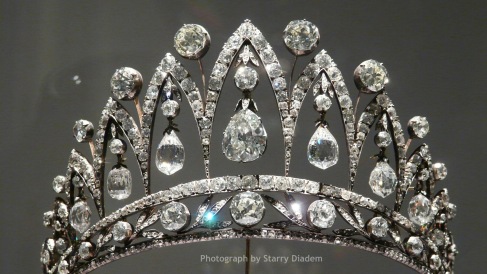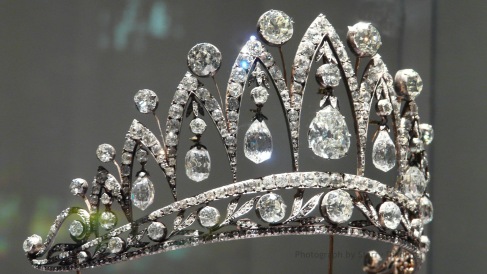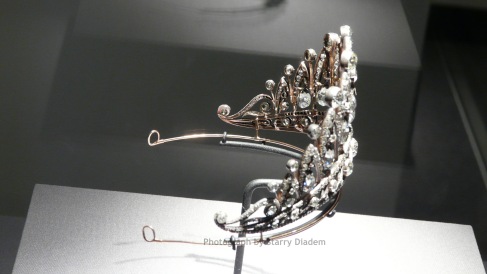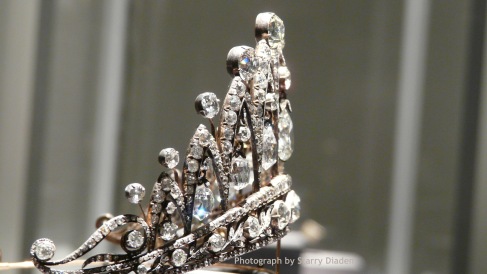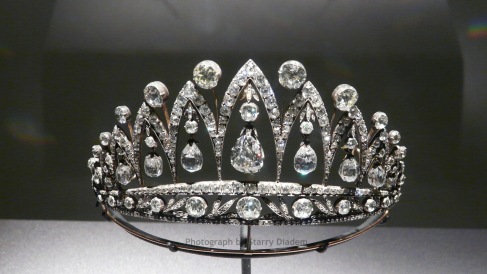Korōnē
Tuesday, 29 April 2014
Platinum, Silver, Diamond and Natural Pearl Pendant
Sold at Doyles, April 2014 for over $3million. The following history is taken from Doyles' Catalogue of the sale:
Rare and Exceptional Platinum, Silver, Diamond and Natural Pearl Pendant
Topped by a looped ribbon set with 23 old-mine cut diamonds approximately 2.00 cts., suspending 2 drop-shaped slightly brownish gray pearls approximately 12.90 to 12.95 x 23.85 mm. and 12.90 to 13.05 x 22.45 mm., with silver and rose-cut diamond-set caps, with later pendant mounting circa 1920. With fitted box.
With SSEF report no. 72885 stating that the pearls are saltwater natural, with no indications of artificial colour modification.
With SSEF appendix letter stating that the "... matching pair of natural pearls of this size and quality is very rare and exceptional, and thus this pair of pearls can be considered a very exceptional treasure of nature."
The lot is accompanied by a note stating in ink: History of Empress Eugenie's Black Pearls & Necklace Brought to this country by George Crocker. Kept by his wife & his daughter Mrs. Philip Kearny _ Emma Rutherford. These in possession of Henry R. Benjamin for his eldest daughter. With an additional notation in pencil: Given to Dorothy R. Benjamin to wear on Xmas 1925 and hold until Anne R. B. is of age. HRB. A notation on the reverse states in ink: Sometime must be put on top of box neck (necklace?) pearls in Guaranty Safe Deposit box 789. So careful of keys. And in a different hand, below the fold: Roger
The Crocker Family
George Crocker (1856-1909) was the son of Charles Crocker, who founded the Central Pacific Railroad in California and left a fortune estimated between $300-400 million at his death in 1888. In 1894, George married California mining heiress Emma (Hanchette) Rutherford, a widow with three grown children. The new couple settled in New York and built an imposing Beaux-Arts townhouse on the corner of Fifth Avenue and 64th Street. They also owned Shields Villa, a "cottage" at Ochre Point in Newport, RI, and they built a lavish country estate in Darlington, near Ramapo, NJ. In 1903, their youngest daughter, Emma Wallace Rutherford, married Philip Kearny, the son of General John Watts Kearny of Washington, DC.
The Rogers Family
Henry Huttleston Rogers (1840-1909) of Fairhaven, MA, was an American industrialist who made a fortune as a partner in Standard Oil and a founder of the Virginia Railroad. He and his wife, Abbie Palmer Gifford, both descended from families who had arrived on the Mayflower. He was also a close friend and confidant of author and humorist Mark Twain.
Henry Huttleston Rogers' grandson, Henry Rogers Benjamin, married Dorothy Rennard, who wore the pearls on Christmas, 1925. Their daughter, Anne Rogers Benjamin, wore the pearls at her debut in 1941 at a ball hosted in her honor by her aunt, Beatrice Benjamin Cartwright, in the ballroom of New York's St. Regis Hotel.
In 1945, Anne Rogers Benjamin married Robert Raymond Barry, and the couple settled in Bronxville, NY. In the 1959, he was elected to the United States House of Representatives, where he served three terms.
The Sale of the French Crown Jewels
The note accompanying the lot mentions Empress Eugenie. In 1887, following the fall of Napoleon III and his wife, Empress Eugenie, an historic auction of the French Crown Jewels took place in the Louvre, lasting twelve days. The New York firm of Tiffany & Co. was the largest purchaser at the sale, successfully buying almost a third of the crown Jewels.
Provenance:
George Crocker, by descent to his daughter
Emma Wallace Rutherford (Mrs. Philip Kearny)
Acquired circa 1925 by
Henry Rogers Benjamin, by descent to his daughter
Anne Rogers Benjamin (Mrs. Robert R. Barry), by descent to her daughter
Mrs. Lewis A. Shea
Saturday, 9 November 2013
The Kelch Adaptable Tiara
First of all, there was this:
This image is all over Pinterest as the Anhalt honeysuckle tiara. An understandable mistake, as its first appearance was on the Coloured Diamond board right next to the real Anhalt tiara and this one was unattributed. I labelled it as the Anhalt myself, and I should have known better because ‘honeysuckle’ this is not. In any event, opal tiaras are rare and this pretty garland version was welcomed heartily by those of us who love both tiaras and opals.
Then this all diamond version appeared:
Personally, I don’t like the flower drops. They look rather twee, but it was exciting because adaptable tiaras are as rare as opals, and it’s very satisfying that we had a new one to coo over.
Then, a few months ago an image of yet another variant turned up:
It’s a very low resolution image, and it’s impossible to tell if these are pearls (they seem quite lustrous) or cabochon emeralds (it appears that you can see the shank within each tear drop, which of course you wouldn’t be able to do with pearls). The jury is out on this one. I originally thought they were pearls, but the longer I look at it the more doubtful I am. However, until we get a definitive ruling (or a colour photo) then we’ll have to remain uncertain and doubtful.
And finally, Federica Capocchi on Pinterest pinged me about this one yesterday:
Federica had found it in her copy of Meylan’s “Boucheron: The Secret Archives.” In case you’re wondering, the book’s on my Christmas list and the husband has promised faithfully that it will be in my stocking on Christmas morning. Until then, I have to get my Boucheron thrills second hand.
Now it may seem sad to you, but for Federica, Edie Engel and me, this was a moment of high excitement. We had a fourth form for this tiara, we had a maker, a date, and the name of the woman it was made for. For tiara lovers, there can be no finer sense of achievement.
And what a story is connected to it!
Barbara Kelch - Varvara Petrovna Bazanova – was the wife of Alexander Ferdinandovich Kelch, a Russian nobleman who lived in St Petersburg at the end of the nineteenth century. He is now known mainly as a patron of Fabergé, having commissioned seven eggs for Barbara, one each year from 1898 - 1904. These eggs are famous ones in the Fabergé aficionado circle, and deemed to be of the same quality as the ones Fabergé made for the Tsar and the Imperial family. One or two are considered outstanding examples of the art. More on those in a moment.
The following is taken from Fabergé Eggs: A Retrospective Encyclopedia by Will Lowes, Christel Ludewig :
Alexander Kelch was a titled industrialist and gold magnate who married Varvara (Barbara) in 1894. Her family had made a fortune in Siberian industry, particularly gold-mining. Just two years previously, she had married Alexander’s brother Nikolai, but he died very early and her wedding to Alexander appears to have been arranged to keep the two merchant families allied. To begin with, they didn’t live together: she was in Moscow and he lived in St Petersburg. In 1896, the couple bought a mansion at 28 Sergeevskaia Ulitsa in one of St Petersburg’s most fashionable areas, for 300,000 roubles.
Edie tracked down a picture of the house, which is still extant:
If you're interested in knowing more about the house, go here
Barbara moved to St Petersburg in 1898, the first year that she received a Fabergé egg from Alexander. The eggs were all made by Fabergé’s premier workmaster, Mikhail Perkhin. They are, in order:
1898 Hen egg
1899 12 panel egg
1900 Pine Cone egg (considered a masterpiece)
1901 Apple Blossom Egg
1902 Rocaille Egg (now in the McFerrin Fabergé Collection housed in the Houston Museum of Natural Sciences (http://www.gia.edu/gems-gem... ).
1903 Bonbonniere Egg
1904 Chanticleer Egg
If you want to know more about the eggs then the Encyclopaedia is the way to go, since this is all I’m going to say about them here. Frankly, Fabergé eggs leave me pretty cold. His few tiaras, now, are a very different kettle of fish.
1904 marked the high point in the finances of the family. The Russo-Japanese War of 1904/5 destabilised the economy so badly even wealthy families suffered and the couple separated in 1905 with Barbara moving to Paris. According to Orthodox tradition, the marriage was formally annulled ten years later. She must have taken a lot of her belongings with her, because in 1920, six of the eggs (all but the 1899 12-panel egg)were offered for sale by the Paris jeweller Morgan and sold to Jacques Zolotnitsky, whose nephew sold the eggs on to an American buyer in 1928.
Alexander worked in the mining industry in Siberia and remarried. He returned to St Petersburg in 1924, and was in correspondence with Barbara as four years later she was urging him to come to Paris. He opted to stay with his new family, aware that Barbara herself was short of money. He was arrested in 1930, tried, and sentenced to hard labour. It’s thought he died in a Siberian gulag.
So far, no information is available on Barbara’s life after this and until I get hold of Meylan’s book for myself, I probably won’t be able to update with information on the fate of the tiara.
So there you have it. The story behind one of the prettiest adaptable tiaras around.
Then this all diamond version appeared:
Personally, I don’t like the flower drops. They look rather twee, but it was exciting because adaptable tiaras are as rare as opals, and it’s very satisfying that we had a new one to coo over.
Then, a few months ago an image of yet another variant turned up:
It’s a very low resolution image, and it’s impossible to tell if these are pearls (they seem quite lustrous) or cabochon emeralds (it appears that you can see the shank within each tear drop, which of course you wouldn’t be able to do with pearls). The jury is out on this one. I originally thought they were pearls, but the longer I look at it the more doubtful I am. However, until we get a definitive ruling (or a colour photo) then we’ll have to remain uncertain and doubtful.
And finally, Federica Capocchi on Pinterest pinged me about this one yesterday:
Federica had found it in her copy of Meylan’s “Boucheron: The Secret Archives.” In case you’re wondering, the book’s on my Christmas list and the husband has promised faithfully that it will be in my stocking on Christmas morning. Until then, I have to get my Boucheron thrills second hand.
Now it may seem sad to you, but for Federica, Edie Engel and me, this was a moment of high excitement. We had a fourth form for this tiara, we had a maker, a date, and the name of the woman it was made for. For tiara lovers, there can be no finer sense of achievement.
And what a story is connected to it!
Barbara Kelch - Varvara Petrovna Bazanova – was the wife of Alexander Ferdinandovich Kelch, a Russian nobleman who lived in St Petersburg at the end of the nineteenth century. He is now known mainly as a patron of Fabergé, having commissioned seven eggs for Barbara, one each year from 1898 - 1904. These eggs are famous ones in the Fabergé aficionado circle, and deemed to be of the same quality as the ones Fabergé made for the Tsar and the Imperial family. One or two are considered outstanding examples of the art. More on those in a moment.
The following is taken from Fabergé Eggs: A Retrospective Encyclopedia by Will Lowes, Christel Ludewig :
Alexander Kelch was a titled industrialist and gold magnate who married Varvara (Barbara) in 1894. Her family had made a fortune in Siberian industry, particularly gold-mining. Just two years previously, she had married Alexander’s brother Nikolai, but he died very early and her wedding to Alexander appears to have been arranged to keep the two merchant families allied. To begin with, they didn’t live together: she was in Moscow and he lived in St Petersburg. In 1896, the couple bought a mansion at 28 Sergeevskaia Ulitsa in one of St Petersburg’s most fashionable areas, for 300,000 roubles.
Edie tracked down a picture of the house, which is still extant:
If you're interested in knowing more about the house, go here
Barbara moved to St Petersburg in 1898, the first year that she received a Fabergé egg from Alexander. The eggs were all made by Fabergé’s premier workmaster, Mikhail Perkhin. They are, in order:
1898 Hen egg
1899 12 panel egg
1900 Pine Cone egg (considered a masterpiece)
1901 Apple Blossom Egg
1902 Rocaille Egg (now in the McFerrin Fabergé Collection housed in the Houston Museum of Natural Sciences (http://www.gia.edu/gems-gem... ).
1903 Bonbonniere Egg
1904 Chanticleer Egg
If you want to know more about the eggs then the Encyclopaedia is the way to go, since this is all I’m going to say about them here. Frankly, Fabergé eggs leave me pretty cold. His few tiaras, now, are a very different kettle of fish.
1904 marked the high point in the finances of the family. The Russo-Japanese War of 1904/5 destabilised the economy so badly even wealthy families suffered and the couple separated in 1905 with Barbara moving to Paris. According to Orthodox tradition, the marriage was formally annulled ten years later. She must have taken a lot of her belongings with her, because in 1920, six of the eggs (all but the 1899 12-panel egg)were offered for sale by the Paris jeweller Morgan and sold to Jacques Zolotnitsky, whose nephew sold the eggs on to an American buyer in 1928.
Alexander worked in the mining industry in Siberia and remarried. He returned to St Petersburg in 1924, and was in correspondence with Barbara as four years later she was urging him to come to Paris. He opted to stay with his new family, aware that Barbara herself was short of money. He was arrested in 1930, tried, and sentenced to hard labour. It’s thought he died in a Siberian gulag.
So far, no information is available on Barbara’s life after this and until I get hold of Meylan’s book for myself, I probably won’t be able to update with information on the fate of the tiara.
So there you have it. The story behind one of the prettiest adaptable tiaras around.
Monday, 26 August 2013
Three new Russian tiaras
The appearance of this image on Pinterest around 20/08/2012
sparked off a spate of detective work involving me and fellow Pinterest users Marion Van Der Fluit, Frederica Capocchi and Edie Engel.
The pin appeared on my ‘feed’ labelled as tiaras belonging
to Empress Alexandra Feodorovna. That’s suspicious for a start, because the
Russian crown jewels were extensively catalogued after the Revolution, and
these three tiaras are completely new to me. Of course, the romance of the
Romanovs is that pretty much anything sparkly with a Russian origin is
attributed to them (and is assumed to have been made by Faberge) because that’s
all that most people think of when they think “Russia”. Any Romanov attribution
to a previously unknown object had to be treated with a grain of salt!
Edie made the first link to a Russian blog where
the tiaras were attributed to S. P Durnovo and listed as (top to bottom):
a diamond and
turquoise tiara in kokoshnik shape
a diamond and opal
tiara
a naturalistic
diamond tiara
So the search was on.
Marion and I found this same reference at about the same
instant, I think, trading the link. It crossed in the aether!
S P Durnovo is likely to be Sofia
(or Sophia) Petrovna Durnovo, who is pictured in attendance at the Romanov
Anniversary Ball in 1903 and is said to have been born Sophia Petrovna
Volkonsky (or Wolkonsky). The Wolkonskys were a princely family :
As was usual when attending formal Russian court functions,
she is wearing traditional boyer dress and wearing a kokoshnik.
Now the hunt was on to find out more about her.
Edie’s link to a site tracing the extensive genealogy of
the Wolkonsky family yielded the information that she was the daughter of
Pjotr Wolkonsky and his wife, Countess Olga Kleinmichel and she had married twice: " 2d) Pjotr
(St.Petersburg 24 Jan 1845-Yalta 2 Jan 1920); m. St.Petersburg 3 Apr 1866 Css
Olga Petrovna Kleinmichel (St.Petersburg 17 Sep 1845-Tschudovo 23 Jul 1919) 1e)
Sophia (St.Petersburg 28 Jan 1867-Starnberg 11 Apr 1943); m.1st Moscow 11 Nov
1885 Danis Davydov (d. St.Petersburg 5 Aug 1896); m.2nd Cannes 26 Mar 1901
Pawel Durnovo (d.Athens 21 Jan 1909)"
A little disentanglement of the family tree gives us:
There is confirmatory information about them on another
genealogy site found by Frederica, which allows us to trace her mother’s
family a little and gives us a few portraits, and confirms that she had a
daughter, Alexandra, by Pavel (or Pawel) Durnovo.
Olga, Sophia’s mother (1845
– 1920).
Marion’s contact in Russia yielded this snipped in relation
to Sophia’s first marriage:
Widow of Guard Lieutenant Davydov,
Sofia Petrovna, Dark Princess Volkonskaia. After her husband's death, she gave
the Marine Corps his yacht "Pavlik." Also on 16 December 1909 she established
an annual award in his memory to the amount of 500 roubles for members of the
Marine Corps.
(Source unknown, but I just love that description of her as Dark Princess. Lovely!)
(Source unknown, but I just love that description of her as Dark Princess. Lovely!)
Sophia’s second husband Pavel Durnovo is from an interesting
family in his own right. He was the son of Pjotr
Nickoleyovich Durnovo (1845 – 1915) one of the last Tsar’s ministers and
famous for the memorandum
in which he outlined the case for aligning with Germany, not Britain, in the
war he saw was coming. His argument was that war between Germany and Russia
would lead to the end of both empires. A very intelligent and far seeing man,
if noted for being a reactionary.
Pjotr Nicoleyovich Durnovo
Pjotr Nicoleyovich was also the last Russian Imperial
Minister of Interior whose death was by natural causes. His six successors were
assassinated or murdered during the “Red Terror”.
Pavel’s brother, Pjotr, was the first husband of Marianna,
Countess Hohenfelsen, nee Marianna Erikovna von Pistohikors. She was the
daughter of Princess Paley by her first marriage. Princess Paley became the morganatic
wife of Grand Duke Paul Alexandrovich and owned a magnificent Cartier
aquamarine parure. Marianna married twice subsequently and had a minor
acting career in Hollywood.
The tiaras
themselves
The image appears in AE Felkerzam’s
"Jewelry (from) the time of Alexander I” a scholarly
article/book. Google Translate offers this about the tiaras:
“…we see the tiara on top of turquoise and diamonds, Russian
type, reminiscent of the kokoshnik form. The second tiara of diamonds with very
large charming opals, is typical of the times, "Restoration", and the
third consisting of diamond flowers and leaves, too, refers to the 20 th year (my
query -20 th century?). It is close to a headdress, composed of tiaras
and crest of wild flowers and ears…”
The author doesn’t appear to attribute them
to Sophia, so the quest for confirmation goes on... Any information will be gratefully received!
Tuesday, 11 June 2013
The Faberge Empress Josephine (or Leuchtenberg) Tiara
Tiaras aren't everyone's cup of tea, I know, but I adore them. They're frivolous and cruelly expensive bits of frippery, and yes, I know that in today's earnest, take-issues-seriously world, I should be concerning myself with gay rights or ending hunger and oppression--and believe me, most days I do just that--but just once in a while I want to be frivolous too. They are amongst the loveliest of adornments which, when they catch the light, scintillate shamelessly (in Geoffrey Munn's immortal phrase). They're just beautiful.
This isn't my favourite tiara (that's the Hunt and Roskill diamond oakleaf and acorn tiara in the British Museum) but I certainly wouldn't object if Mr Butler took it into his head to acquire several millions of pounds so he could drop it into my lap. Imagine my delight when I discovered the tiara, along with dozens of other Fabergé items, is on permanent display at the Houston Museum of Natural Sciences. Is it any wonder that I was so keen to go to Galacticon3 to do that writing workshop?!
There are not many Fabergé tiaras in existence. This one, only 5.2" wide, is known as the Empress Josephine tiara or sometimes the Leuchtenberg tiara, but as it was made by Fabergé’s workmaster August Holmström in 1890 and the Empress died in 1814, it was certainly never hers.
However, some of the diamonds were. The briolette-cut (i.e. drop-shaped) diamonds in the tiara were a gift from Emperor Alexander I of Russia to Josephine when he visited La Malmaison following her divorce from Napoleon, perhaps as a part-payment for an important collection of old master paintings which the Emperor acquired from her and is still in the Hermitage today.
The Leuchtenberg title was given to Eugène de Beauhamais, the son of the Empress Josephine and the adopted stepson of Napoleon, when Eugène married Princess Augusta of Bavaria. Their youngest son married the eldest daughter of Emperor Nicholas I, which explains why diamonds given by an Emperor of Russia to the Empress Josephine, ended up in the tiara of a Russian princess.
The Leuchtenberg family sold the tiara during WWI, and it was bought by the Belgium royal family. When Queen Elisabeth of Belgium died in 1965, her son Prince Charles Theodore (1903-83) inherited it. The tiara then passed to his sister, Queen Maria José (1906-2001) the last Queen of Italy. Princess Maria Gabriella, her daughter, inherited the tiara in 2001 and put it up for auction in 2007.
The tiara was bought by the McFerrin family, who have collected Fabergé items for years and have put their collection on permanent loan to the Houston Museum of Natural Sciences. It's an extraordinary collection of items with everything from famous Fabergé eggs to parasol handles to the tiara. The generosity of the McFerrin's is laudable. One of the curators at the museum told me that the family had so much Fabergé, that they'd turn up for meetings at the museum while discussing the loan, pull some priceless item from their pocket where it had been jostling around with their handkerchief and wallet, and say "Oh, here. Have this one as well."
I wish they'd thought of me when they were doing that. Tch.
So there you are. The potted history of a glorious work of art. If ever you go to Houston, don't miss it.
Tuesday, 1 January 2013
Hunt and Roskell Oak Leaf Tiara
This tiara, created by Hunt and Roskell circa 1855 is my all-time favourite. A design of oak leaves and acorns in diamonds set in open-backed silver and gold, its three elements (two side pieces, one central oak leaf spray) can be dismounted from the frame and worn as a devant de corsage or the side elements can be worn on a pair of tortoiseshell combs.
Detail of a side piece:
The original case still exists, labelled Hunt & Roskell, New Bond Street. The case
is stamped with a Viscount's coronet and the initials 'MP'- likely Mary
Selina Charlotte Portman, daughter of Viscount Milton, who married 2nd
Viscount Portman June, 1855.
 The case holds 2 tortoise-shell
combs and the gold frames for the tiara and brooch, as well as the three jewelled elements themselves. The jewelled elements
are interchangeable between the combs, the brooch-frame and tiara.
The case holds 2 tortoise-shell
combs and the gold frames for the tiara and brooch, as well as the three jewelled elements themselves. The jewelled elements
are interchangeable between the combs, the brooch-frame and tiara.
All three elements combined to make the devant-de-corsage:
And the two side pieces mounted onto the combs:
Dimensions
Width: 4.8 centimetres (central spray)
Width: 9.3 centimetres (outer sprays; comb-mounts)
Diameter: 16.3 centimetres (circlet)
Width: 4.8 centimetres (central spray)
Width: 9.3 centimetres (outer sprays; comb-mounts)
Diameter: 16.3 centimetres (circlet)
In 1970, the tiara was auctioned by Sotheby's, and bought by an extraordinary jewellery collector, Ann Hull-Grundy (1926 -1984). The following is adapted from the Fitwilliam Museum's site:
Born into a Jewish banking and industrial family in Nuremberg in 1926, Anne Hull Grundy, née Ullmann, left Germany for England when Hitler rose to power in 1933. Her father re-established the family’s manufacture of metal lithographed pressed toys in Northampton and by 1939 Mettoy was a successful company. Following the war years, when the company produced jerry cans and machine gun parts, Mettoy introduced the hugely successful Corgi range of die-cast zinc toys. It was these Corgi toys, together with income from the Keyser-Ullman bank, which later provided Hull Grundy with the wealth which enabled her to form one of the finest jewellery collections in the world.
Inspired by her parents, Hull Grundy started collecting when she was eleven. Disabled by a respiratory condition at the age of twenty-one, which first tied her to a wheelchair and ultimately to her bed, she dedicated her life to the study and collecting of European jewellery and Japanese ivories. Buying many of her treasures by post, she assembled thousands of the most exquisite pieces of jewellery, but only ever wore a wedding band(her husband was the artist and entomologist John Hull Grundy (1907-1984).
Reflecting on her collecting activities later in life, Hull Grundy described herself as 'a large spider sitting at the centre of a web of dealers, salesrooms and museums'. Her ambition was to outwit art dealers and museum curators and to acquire a ‘ticket to life eternal’, in other words set herself and her husband some collection monuments.
Thanks to Hull Grundy, Britain’s museums are much richer in jewellery today. Not necessarily diamonds, which she thought were ‘for call girls and dumb rich wives’, but carefully chosen pieces of antique and modern jewellery. The recipients of biscuit tins filled with precious surprises, no less than 70 collections benefited from her knowledge and generosity over the years. The British Museum was given some of the most important pieces from her collection in 1978, including this tiara.
The tiara is on permanent display at the British Museum.
Subscribe to:
Comments (Atom)














